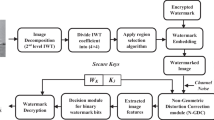Abstract
Karhunen-Loève transform (KLT) is the optimal transform that minimizes distortion at a given bit allocation for Gaussian source. As a KLT matrix usually contains non-integers, integer-KLT design is a classical problem. In this paper, a joint reversibility-gain (R-G) model is proposed for integer-KLT design in video coding. Specifically, the ‘reversibility’ is modeled according to distortion analysis in using forward and inverse integer transform without quantization. It not only measures how invertible a transform is, but also bounds the distortion introduced by the non-orthonormal integer transform process. The ‘gain’ means transform coding gain (TCG), which is a widely used criterion for transform design in video coding. Since KLT maximizes the TCG under some assumptions, here we define the TCG loss ratio (LR) to measure how much coding gain an integer-KLT loses when compared with the original KLT. Thus, the R-G model can be explained as follows: subject to a certain TCG LR, an integer- KLT with the best reversibility is the optimal integer transform for a given non-integer-KLT. Experimental results show that the R-G model can guide the design of integer-KLTs with good performance.
Similar content being viewed by others
References
Ahmed, N., Natarajan, T., Rao, K.R., 1974. Discrete cosine transform. IEEE Trans. Comput., 23(1):90–93. [doi:10.1109/T-C.1974.223784]
Bjontegaard, G., 2001. Calculation of Average PSNR Differences Between RD-Curves. Doc. VCEG-M33 ITU-T Q6/16, Austin, Texas, USA.
Chen, J., 2012. Reconstruction Image Distortion Model Considering the Quality of Reference Frame in Video Coding. MS Thesis, Zhejiang University, Hangzhou, China (in Chinese).
Dong, J., Ngan, K.N., Fong, C.K., et al., 2009. 2-D order-16 integer transforms for HD video coding. IEEE Trans. Circ. Syst. Video Technol., 19(10):1462–1474. [doi:10.1109/TCSVT.2009.2026792]
Goyal, V.K., 2000. High-rate transform coding: how high is high, and does it matter? Proc. IEEE Int. Symp. on Information Theory, p.207. [doi:10.1109/ISIT.2000.866505]
Goyal, V.K., 2001. Theoretical foundations of transform coding. IEEE Signal Process. Mag., 18(5):9–21. [doi:10.1109/79.952802]
Han, J., Saxena, A., Melkeote, V., et al., 2012. Jointly optimized spatial prediction and block transform for video and image coding. IEEE Trans. Image Process., 21(4):1874–1884. [doi:10.1109/TIP.2011.2169976]
Hinds, A.T., Reznik, Ya.., Yu, L., et al., 2007. Drift analysis for integer IDCT. SPIE, 6696:14.1–14.16. [doi:10.1117/12.740220]
Jayant, N.S., Noll, P., 1984. Digital Coding of Waveforms: Principles and Applications to Speech and Video. Prentice-Hall, USA.
Saxena, A., Fernandes, F.C., 2013. Low latency secondary transforms for intra/inter prediction residual. IEEE Trans. Image Process., 22(10):4061–4071. [doi:10.1109/TIP.2013.2270087]
Wiegand, T., 2001. H.26L Test Model Long-Term Number 9 (TML-9) draft0. Doc. VCEG-N83 ITU-T Q6/16, Santa Barbara, CA, USA.
Ye, Y., Karczewicz, M., 2008. Improved H.264 intra coding based on bi-directional intra prediction, directional transform, and adaptive coefficient scanning. Proc. 15th IEEE Int. Conf. on Image Processing, p.2116–2119. [doi:10.1109/ICIP.2008.4712205]
Yeo, C., Tan, Y.H., Li, Z., et al., 2011. Mode-dependent transform for coding directional intra prediction residuals. IEEE Trans. Circ. Syst. Video Technol., 22(4):545–554. [doi:10.1109/TCSVT.2011.2168291]
Zhang, C., Wang, J., Yu, L., 2006. Systematic approach of fixed point 8?8 IDCT and DCT design and implementation. Proc. Picture Coding Symp., p.1–6.
Zhao, X., Zhang, L., Ma, S., et al., 2011. Video coding with rate-distortion optimized transform. IEEE Trans. Circ. Syst. Video Technol., 22(1):138–151. [doi:10.1109/TCSVT.2011.2158363]
Author information
Authors and Affiliations
Corresponding author
Additional information
Project supported by the National Natural Science Foundation of China (Nos. 61371162 and 61431015)
ORCID: Xing-guo ZHU, http://orcid.org/0000-0002-6319-2471
Rights and permissions
About this article
Cite this article
Zhu, Xg., Yu, L. A reversibility-gain model for integer Karhunen-Loève transform design in video coding. Frontiers Inf Technol Electronic Eng 16, 883–891 (2015). https://doi.org/10.1631/FITEE.1500071
Received:
Revised:
Accepted:
Published:
Issue Date:
DOI: https://doi.org/10.1631/FITEE.1500071




